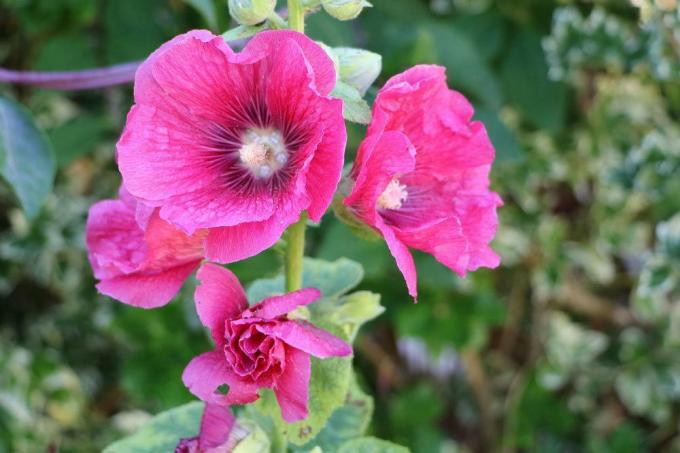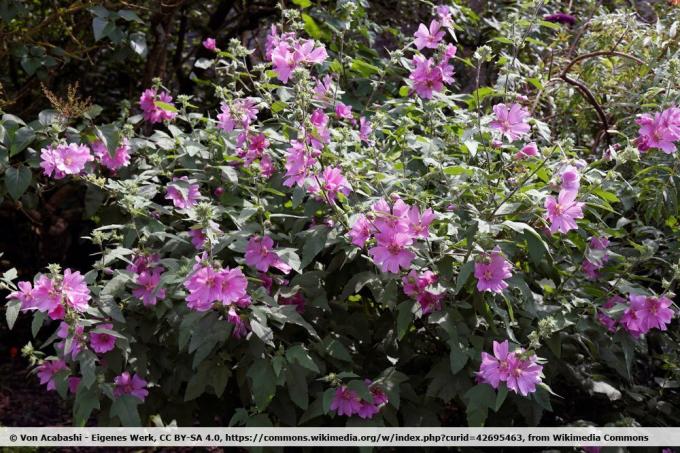
table of contents
- Are mallow family hardy?
- Hardy mallow
- Tree mallow
- Bush mallow
- Mallow
- Hollyhock
- Wild mallow
- Protective measures
- Cut back
Mallow are typical summer plants. You love the sun. In the warm season they transform every garden into a small, colorful paradise with their splendor of flowers. Among the 30 or so varieties in which the mallow family or If the genus Malva has been split up in the meantime, there are, however, some that can also cope with winter excellently. They are hardy with restrictions. However, they still need a little protection against the cold
Are mallow family hardy?
Mallows are an ornament for every garden. In the summer months they enchant with their large, colorful flowers. Basically, they have to have a sunny to partially shaded location for this. It should also be protected from wind and rain. Against this background, it is somewhat surprising that some varieties of this plant genus can also be hardy. In principle, however, it is probably better to say that they are winterproof. Most of them would not survive ice and snow without protection. At least the plants can remain outdoors in the cold season and do not have to be overwintered separately. And the cost of the protective measures is also very limited.
Note: Basically only perennial mallow species are winter-proof. With annuals that have to be re-sown every year, overwintering logically does not work.
In the case of two very popular mallow plants that are often found in our gardens, there is also no question of winter hardiness. These are the cup mallow and the musk mallow. Both have no chance in winter. They should therefore be cultivated in a tub and overwintered in a cool, but frost-free room during the cold season.
Hardy mallow
Of the several thousand species and subspecies of mallow family that can be found worldwide, around 30 have established themselves as ornamental plants in our gardens. In turn, there are some who are more or less coping with winter. As definitely hardy or However, only five mallow plants can be classified as winterproof. These are:
Tree mallow
The tree mallow (bot. Malva arborea) reaches a height of up to 1.5 meters and scores above all with its pink flowers. The flowering time is usually in the months of July, August and September. The plant absolutely needs a sunny, sheltered location and very well drained soil. If these conditions are met, it can easily remain in the garden soil even in winter. Incidentally, it is not really suitable as a container plant.
Bush mallow
The pink flowers of the bush mallow especially attract bees in summer, and they take great pleasure in them. The flowering period extends from July to September. Bush males are extraordinarily lush and expansive plants that can grow up to 1.5 meters. It absolutely needs a sunny location and very nutritious soil. It can easily handle temperatures of down to minus 20 degrees Celsius in winter.
Mallow
This type of the genus Malva is in turn divided into various subspecies. Not all of these mallow plants are really hardy. When buying, it is therefore advisable to pay attention to whether the plant has to be overwintered separately. The often found addition of the name "Zimmerahorn" is a clear indication of this. the Mallow (bot. Abutilon) prefers a bright location and forms red, bell-shaped flowers. It can be up to 2.5 meters tall and usually blooms from July to November.

Hollyhock
The hollyhock, also hollyhock, (bot. Alcea rosea) belonged to those mallows that are sometimes referred to by a completely different name. It is also often called hollyhock. The reason is because in appearance and growth it is actually somewhat reminiscent of a rose on a stick. It usually blooms pink in the months of July to September and can reach a height of up to two meters. She prefers a very sunny, sheltered location. Since the plants can break easily, they definitely need a support.

Wild mallow
The wild mallow (bot. Malva sylvestris) is one of the oldest cultivated plants. It reaches a height of about 1.25 meters and forms pink-violet flowers. The plant typically blooms in the months of May to September. The wild mallow also absolutely needs a sunny location that is as protected from the wind as possible. This generally winter-resistant mallow species is often given one or the other common name. These include, for example, locust tree, cat cheese or piss flower.

Note: Some varieties of mallow are sold as biennial ornamental shrubs. However, their lifespan is usually significantly longer than the specified two years.
Protective measures
The mallow plants listed above are basically all hardy or hardy. winterproof. With the possible exception of the bush mallow, they still need certain protective measures in order to get through the cold season without any problems. This is especially true when the winter is particularly long or particularly icy. Protection against the cold is essential under these conditions. The mallow plants should be covered from the beginning of November. You can either cover the entire shrub or concentrate entirely on the root area. The following materials are suitable for covering:
- Straw mat
- Garden tile
- Fir branches
- general sticks
- loose straw
- leaves
- humus
The material is placed loosely so that the plant is completely covered with it. By the way, a pleasant and very ecological side effect of this measure is that it creates a Can create an excellent habitat by, for example, hedgehogs hibernating wonderfully can.
Cut back
Opinions are divided on the question of whether mallow trees should be cut back before winter. A strong pruning can certainly strengthen the plant. However, the cut must then be as large as possible from the first snow or snow. at the first frost period so that the plant has enough time to recover. The month of September is recommended, after the flowering phase is over. Protective measures are also required if the pruning has taken place.





